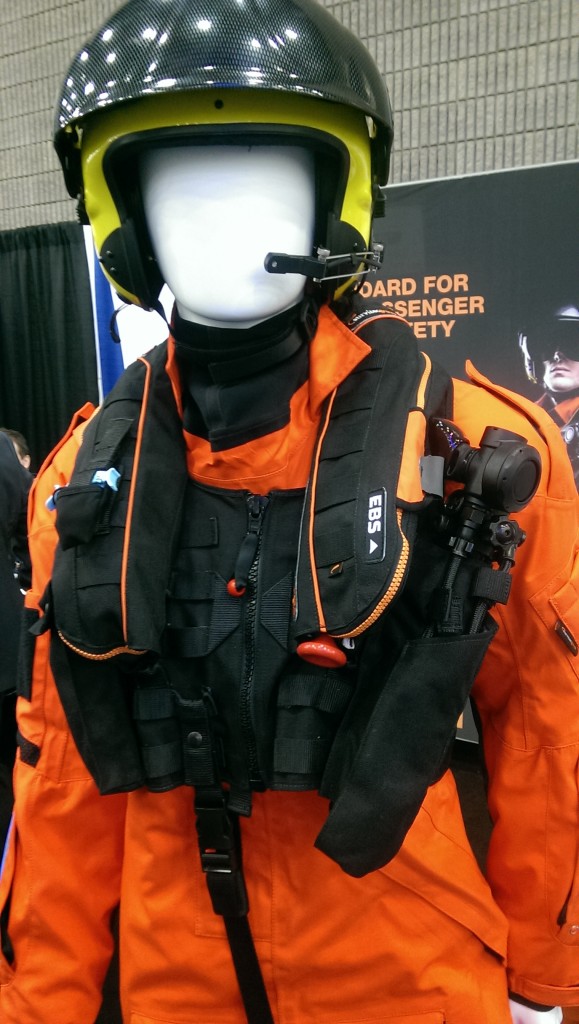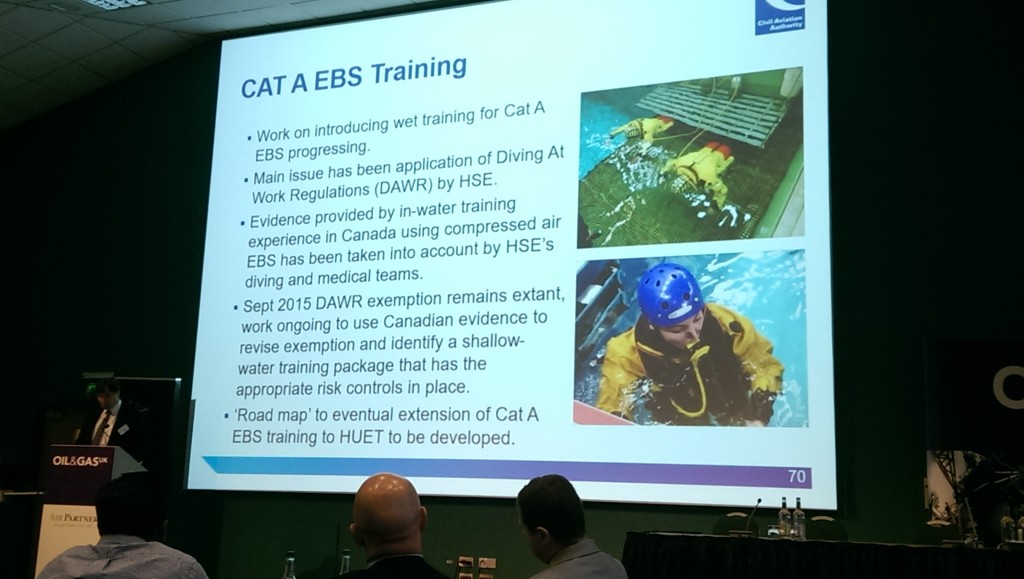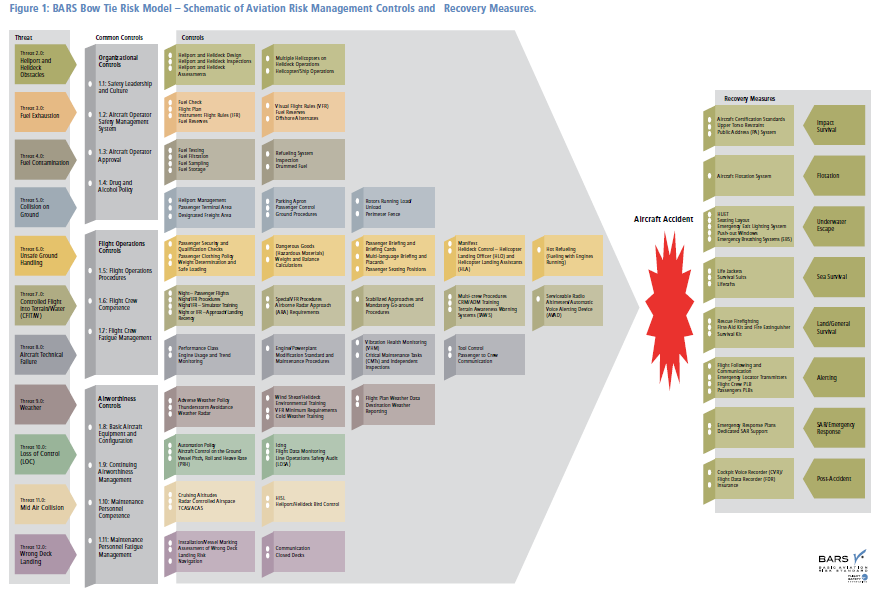UK BOSIET/FOET Cat-A CA-EBS HUET Update
Category A Compressed Air Emergency Breathing Systems (CA-EBS) were introduced for helicopter passengers flying offshore over the UK Continental Shelf in September 2014. This followed the UK Civil Aviation Authority (CAA) North Sea Review, which resulted in the CAP1145 report.
Oil and Gas UK, Step Change in Safety, OPITO, the International Association of Drilling Contractors (IADC) and the Trade Unions have recently agreed a joint statement on the current status of the Helicopter Underwater Escape Training (HUET):
After extensive engagement with industry, regulators, training providers and workforce representatives, agreement has been reached on the new Basic Offshore Safety Induction and Emergency Training (BOSIET) and Further Offshore Emergency Training (FOET) standard to be applied across the UK sector.
This new standard, which will be introduced early in 2016, will meet the manufacturer minimum training requirements specified by the CAA. The standard will involve ‘dry’ Cat A EBS training with in-water HUET breath hold exercises using the Survitec Mk50 [Sentinel] life jacket. This will remove the Lapp jacket and re-breather from the existing BOSIET/FOET standard for personnel travelling offshore in the UKCS.
Passenger wearing a survival suit with a Mk50 Sentinel Life Jacket with Cat A CA-EBS (Credit: Survitec)
In the longer term, all industry stakeholders wish to work towards providing in-water training exercises using the Survitec Mk50 life jacket and Compressed Air Cat A EBS equipment.
This will finally eliminate the anomaly of negative training using the former life jacket (the LAP (aka LAPP) jacket, a hybrid ‘Cat B’ EBS), 17+ months since the Mk50 was introduced (the first with an EBS to be approved by UK CAA in accordance with the Category A specification in CAP1034).
UPDATE 25 January 2016: OPITO has issued an update that the ‘interim’ standard will be introduced across the UK on 15 February 2016. They have provided two sets of FAQs:
The current Health and Safety Executive (HSE) restrictions (due to the applicability of Diving at Work Regulations when breathing pressurised gas) on in-water ‘wet’ CA-EBS training mean that the new interim training standard will feature fewer underwater escapes during HUET. With the LAP jacket for every scenario with breath hold another was also done using the Cat B air pocket within the LAP.
This regulatory challenge was predicted by Survivex in their evidence to the UK CAA in Appendix 5 to Annex D of CAP1145 in October 2013. It has been eased by some time-limited concessions by the HSE in Q3 2015 (although they still require more than a basic offshore medical will involve).
UPDATE 20 September 2016: The UK CAA today briefed the Oil and Gas UK Aviation Seminar the following:
Mk51 Sentinel Aircrew Life Preserver
Survitec have also designed an aircrew jacket with CA-EBS.

Survitec Mk51 Crew Life Jacket with CA-EBS (Note: Nose Clip on Right Hand Stole) (Credit: Aerossurance)
Extra Resources
If you found this article of interest you may also enjoy:
- Rapid Progress with a Category A EBS in the UK following CAP1145
- OPITO Compressed Air Emergency Breathing System (CA-EBS) Initial Deployment Training Standard
- Helicopter Ditching – EASA Rule Making Team RMT.0120 Update on a new rule making initiative in Europe that will shortly proceed to a Notice of Propose Rulemaking
- Dramatic Malaysian S-76C 2013 Ditching Video probably the only video shot from within a helicopter during a real underwater escape
- The Hon Robert Wells QC’s Offshore Helicopter Safety Inquiry (OSHSI) following an S-92A accident offshore Canada in 2009, in which 17 people died and one passenger, Robert Decker, survived.
- The Dangers of Cold Water Immersion
- New Helicopter Survival Suits in Canada for oil and gas flights off the Atlantic coast of Canada
- Norwegian Survival Suits: Suited for Safety
- So You Think The GOM is Non-Hostile? on a fatal US helicopter cold water survival accident in the Gulf of Mexico
- UPDATE 24 January 2016: CAP1145 Helicopter Water Impact Survivability Statistics – A Critique
To better understand the recovery measures of an offshore helicopter accident we recommend the Flight Safety Foundation (FSF) Basic Aviation Risk Standard for Offshore Helicopter Operations (BARSOHO), launched in May 2015.
The standard is orientated around a risk bow-tie, contains a number of common and specific threat controls as well as recovery measures (grouped in distinct categories, for survival after an offshore accident):
The whole BARSOHO standard is freely available, with an accompanying implementation guide. UPDATE 1 February 2017: BARSOHO Version 3, fully aligned with the HeliOffshore Safety Performance Model, is now issued and available.
UPDATE 24 September 2016: The UKCAA has issued CAP1386, their second update on CAP1145. We have summarised that report.
UPDATE 24 May 2017: The Oil and Gas UK Examining Doctors’ Conference discussed the medical assessment necessary for the expected introduction later this year of ‘in-water’ training in the use of Category A EBS on survival courses.
- Oil & Gas UK Examining Doctors’ Conference Agenda
- In Water EBS Training – Background – Trish Sentance, Oil & Gas UK
- Some Diving Physics and Physiology; Barotrauma – Robbert Hermanns, Occupational Health Risk Management Services, Ltd
UPDATE 26 September 2017: ASD-STAN prEN 4856 for Rotorcraft — Emergency Breathing Systems (EBS) — Requirements, testing and marking has been issued. This will then become a full European Standard (EN) via CEN and be incorporated in an EASA ETSO.
UPDATE 12 December 2020: NH90 Caribbean Loss of Control – Inflight, Water Impact and Survivability Issues
UPDATE 9 January 2021: Korean Kamov Ka-32T Fire-Fighting Water Impact and Underwater Egress Fatal Accident




Recent Comments